People Management Report: NHS, Theories, and HR Recommendations
VerifiedAdded on 2023/01/04
|10
|2656
|51
Report
AI Summary
This report provides an in-depth analysis of people management within the National Health Service (NHS). It begins by outlining operational challenges faced by line management, specifically concerning training and development. The report then evaluates various theories and models, including C. Roger's theories, reinforcement theory, and leadership development approaches like contingency theory, which contribute to enhancing employee knowledge, skills, and behavior. Furthermore, it explores team-building techniques, such as the Tuckman model, and motivational theories like Maslow's hierarchy of needs, illustrating their practical application within the NHS. The report also delves into HR processes, including performance management reviews and 360-degree appraisals, highlighting their role in improving employee performance and organizational efficiency. Finally, the report concludes with recommendations for HR processes, focusing on feedback systems, updated job descriptions, and comprehensive training programs to optimize workforce performance and achieve organizational goals.
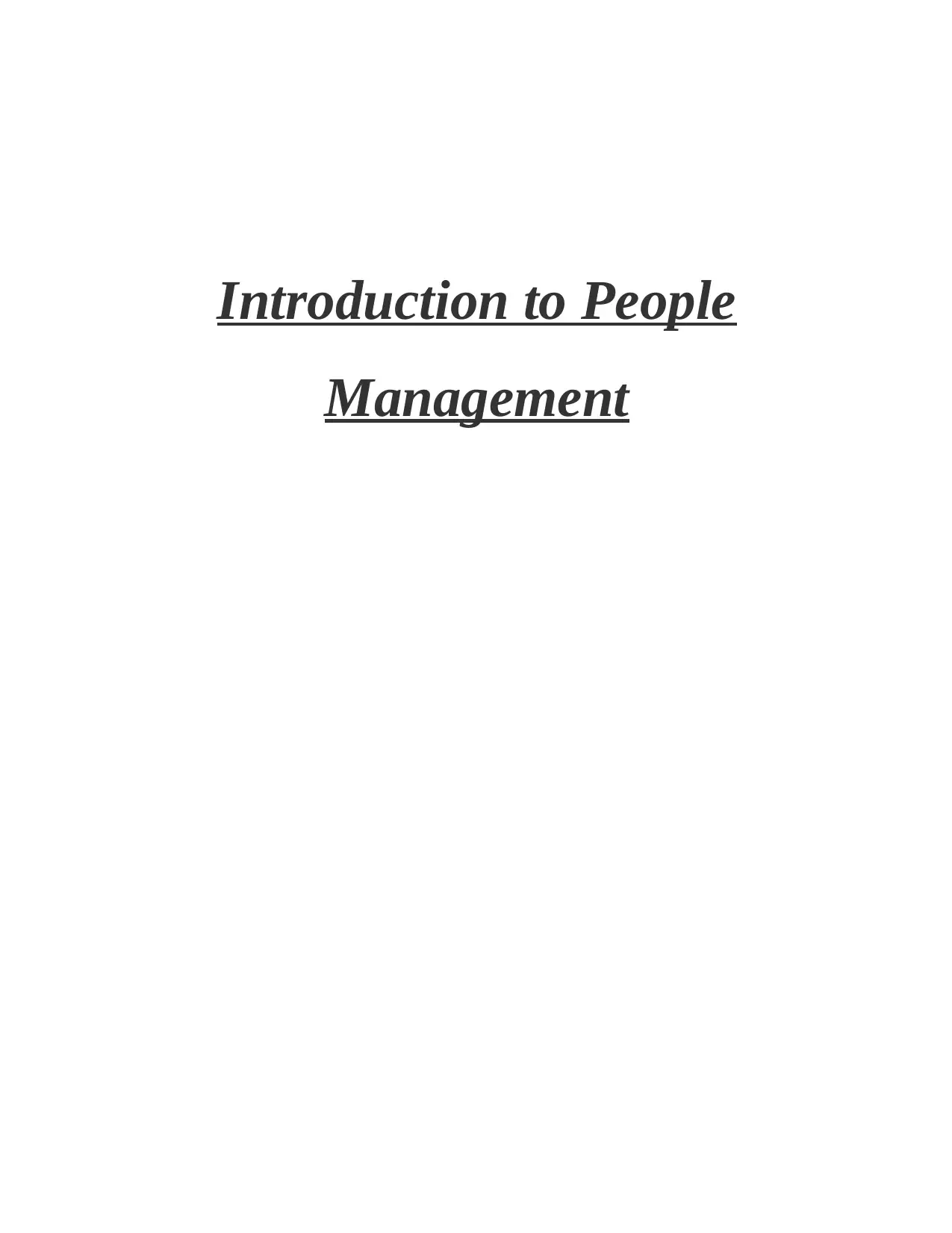
Introduction to People
Management
Management
Paraphrase This Document
Need a fresh take? Get an instant paraphrase of this document with our AI Paraphraser
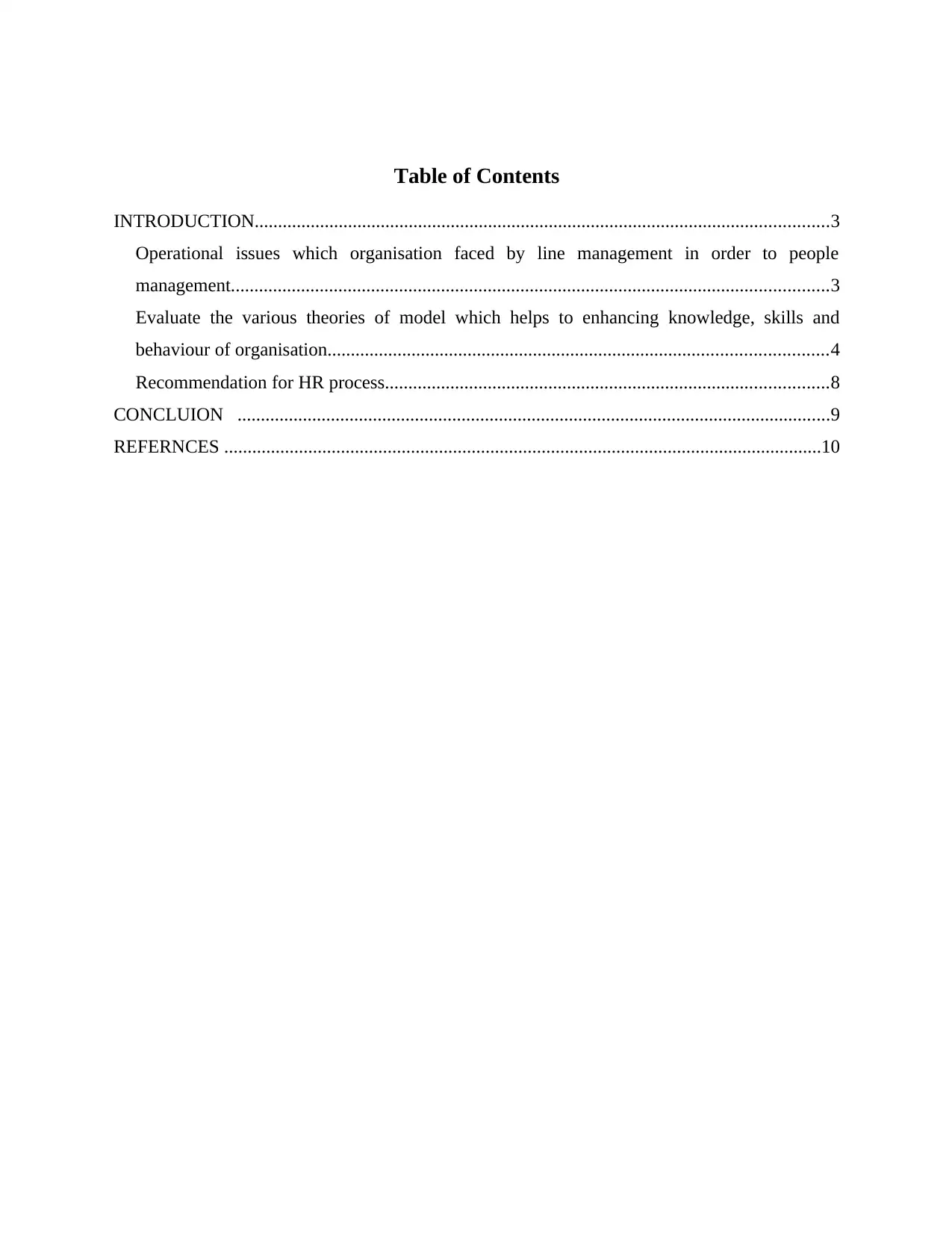
Table of Contents
INTRODUCTION...........................................................................................................................3
Operational issues which organisation faced by line management in order to people
management................................................................................................................................3
Evaluate the various theories of model which helps to enhancing knowledge, skills and
behaviour of organisation...........................................................................................................4
Recommendation for HR process...............................................................................................8
CONCLUION ...............................................................................................................................9
REFERNCES ................................................................................................................................10
INTRODUCTION...........................................................................................................................3
Operational issues which organisation faced by line management in order to people
management................................................................................................................................3
Evaluate the various theories of model which helps to enhancing knowledge, skills and
behaviour of organisation...........................................................................................................4
Recommendation for HR process...............................................................................................8
CONCLUION ...............................................................................................................................9
REFERNCES ................................................................................................................................10
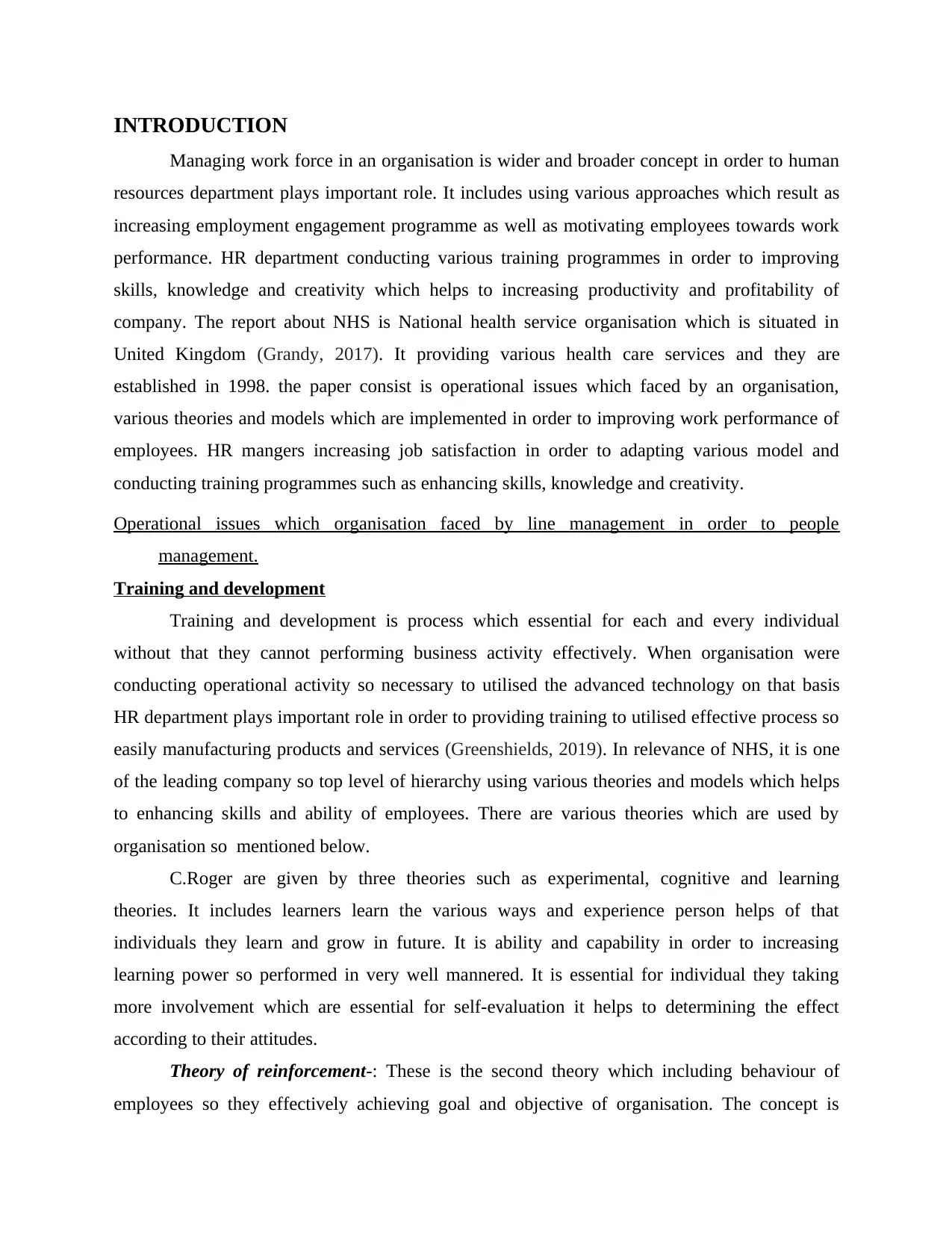
INTRODUCTION
Managing work force in an organisation is wider and broader concept in order to human
resources department plays important role. It includes using various approaches which result as
increasing employment engagement programme as well as motivating employees towards work
performance. HR department conducting various training programmes in order to improving
skills, knowledge and creativity which helps to increasing productivity and profitability of
company. The report about NHS is National health service organisation which is situated in
United Kingdom (Grandy, 2017). It providing various health care services and they are
established in 1998. the paper consist is operational issues which faced by an organisation,
various theories and models which are implemented in order to improving work performance of
employees. HR mangers increasing job satisfaction in order to adapting various model and
conducting training programmes such as enhancing skills, knowledge and creativity.
Operational issues which organisation faced by line management in order to people
management.
Training and development
Training and development is process which essential for each and every individual
without that they cannot performing business activity effectively. When organisation were
conducting operational activity so necessary to utilised the advanced technology on that basis
HR department plays important role in order to providing training to utilised effective process so
easily manufacturing products and services (Greenshields, 2019). In relevance of NHS, it is one
of the leading company so top level of hierarchy using various theories and models which helps
to enhancing skills and ability of employees. There are various theories which are used by
organisation so mentioned below.
C.Roger are given by three theories such as experimental, cognitive and learning
theories. It includes learners learn the various ways and experience person helps of that
individuals they learn and grow in future. It is ability and capability in order to increasing
learning power so performed in very well mannered. It is essential for individual they taking
more involvement which are essential for self-evaluation it helps to determining the effect
according to their attitudes.
Theory of reinforcement-: These is the second theory which including behaviour of
employees so they effectively achieving goal and objective of organisation. The concept is
Managing work force in an organisation is wider and broader concept in order to human
resources department plays important role. It includes using various approaches which result as
increasing employment engagement programme as well as motivating employees towards work
performance. HR department conducting various training programmes in order to improving
skills, knowledge and creativity which helps to increasing productivity and profitability of
company. The report about NHS is National health service organisation which is situated in
United Kingdom (Grandy, 2017). It providing various health care services and they are
established in 1998. the paper consist is operational issues which faced by an organisation,
various theories and models which are implemented in order to improving work performance of
employees. HR mangers increasing job satisfaction in order to adapting various model and
conducting training programmes such as enhancing skills, knowledge and creativity.
Operational issues which organisation faced by line management in order to people
management.
Training and development
Training and development is process which essential for each and every individual
without that they cannot performing business activity effectively. When organisation were
conducting operational activity so necessary to utilised the advanced technology on that basis
HR department plays important role in order to providing training to utilised effective process so
easily manufacturing products and services (Greenshields, 2019). In relevance of NHS, it is one
of the leading company so top level of hierarchy using various theories and models which helps
to enhancing skills and ability of employees. There are various theories which are used by
organisation so mentioned below.
C.Roger are given by three theories such as experimental, cognitive and learning
theories. It includes learners learn the various ways and experience person helps of that
individuals they learn and grow in future. It is ability and capability in order to increasing
learning power so performed in very well mannered. It is essential for individual they taking
more involvement which are essential for self-evaluation it helps to determining the effect
according to their attitudes.
Theory of reinforcement-: These is the second theory which including behaviour of
employees so they effectively achieving goal and objective of organisation. The concept is
⊘ This is a preview!⊘
Do you want full access?
Subscribe today to unlock all pages.

Trusted by 1+ million students worldwide
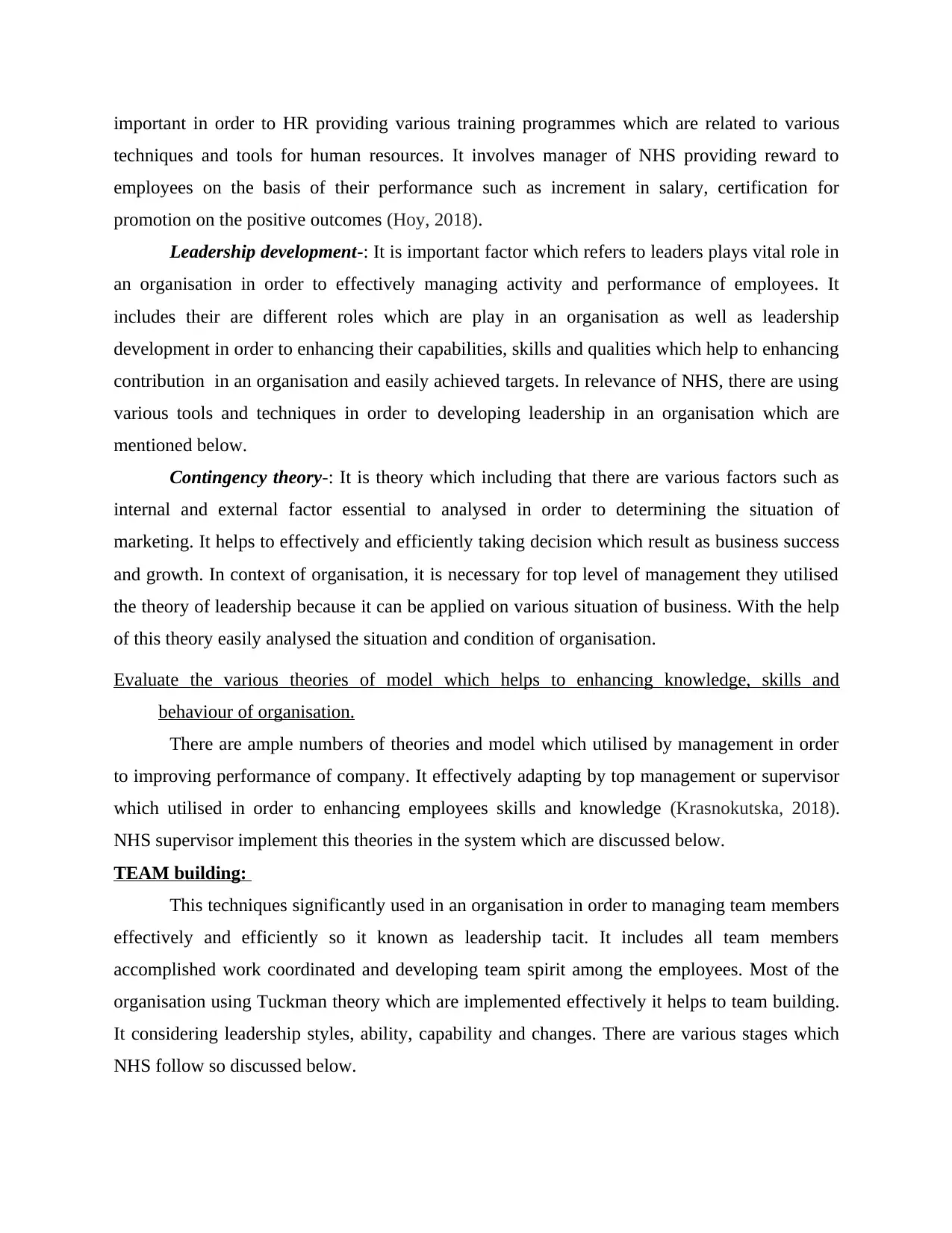
important in order to HR providing various training programmes which are related to various
techniques and tools for human resources. It involves manager of NHS providing reward to
employees on the basis of their performance such as increment in salary, certification for
promotion on the positive outcomes (Hoy, 2018).
Leadership development-: It is important factor which refers to leaders plays vital role in
an organisation in order to effectively managing activity and performance of employees. It
includes their are different roles which are play in an organisation as well as leadership
development in order to enhancing their capabilities, skills and qualities which help to enhancing
contribution in an organisation and easily achieved targets. In relevance of NHS, there are using
various tools and techniques in order to developing leadership in an organisation which are
mentioned below.
Contingency theory-: It is theory which including that there are various factors such as
internal and external factor essential to analysed in order to determining the situation of
marketing. It helps to effectively and efficiently taking decision which result as business success
and growth. In context of organisation, it is necessary for top level of management they utilised
the theory of leadership because it can be applied on various situation of business. With the help
of this theory easily analysed the situation and condition of organisation.
Evaluate the various theories of model which helps to enhancing knowledge, skills and
behaviour of organisation.
There are ample numbers of theories and model which utilised by management in order
to improving performance of company. It effectively adapting by top management or supervisor
which utilised in order to enhancing employees skills and knowledge (Krasnokutska, 2018).
NHS supervisor implement this theories in the system which are discussed below.
TEAM building:
This techniques significantly used in an organisation in order to managing team members
effectively and efficiently so it known as leadership tacit. It includes all team members
accomplished work coordinated and developing team spirit among the employees. Most of the
organisation using Tuckman theory which are implemented effectively it helps to team building.
It considering leadership styles, ability, capability and changes. There are various stages which
NHS follow so discussed below.
techniques and tools for human resources. It involves manager of NHS providing reward to
employees on the basis of their performance such as increment in salary, certification for
promotion on the positive outcomes (Hoy, 2018).
Leadership development-: It is important factor which refers to leaders plays vital role in
an organisation in order to effectively managing activity and performance of employees. It
includes their are different roles which are play in an organisation as well as leadership
development in order to enhancing their capabilities, skills and qualities which help to enhancing
contribution in an organisation and easily achieved targets. In relevance of NHS, there are using
various tools and techniques in order to developing leadership in an organisation which are
mentioned below.
Contingency theory-: It is theory which including that there are various factors such as
internal and external factor essential to analysed in order to determining the situation of
marketing. It helps to effectively and efficiently taking decision which result as business success
and growth. In context of organisation, it is necessary for top level of management they utilised
the theory of leadership because it can be applied on various situation of business. With the help
of this theory easily analysed the situation and condition of organisation.
Evaluate the various theories of model which helps to enhancing knowledge, skills and
behaviour of organisation.
There are ample numbers of theories and model which utilised by management in order
to improving performance of company. It effectively adapting by top management or supervisor
which utilised in order to enhancing employees skills and knowledge (Krasnokutska, 2018).
NHS supervisor implement this theories in the system which are discussed below.
TEAM building:
This techniques significantly used in an organisation in order to managing team members
effectively and efficiently so it known as leadership tacit. It includes all team members
accomplished work coordinated and developing team spirit among the employees. Most of the
organisation using Tuckman theory which are implemented effectively it helps to team building.
It considering leadership styles, ability, capability and changes. There are various stages which
NHS follow so discussed below.
Paraphrase This Document
Need a fresh take? Get an instant paraphrase of this document with our AI Paraphraser
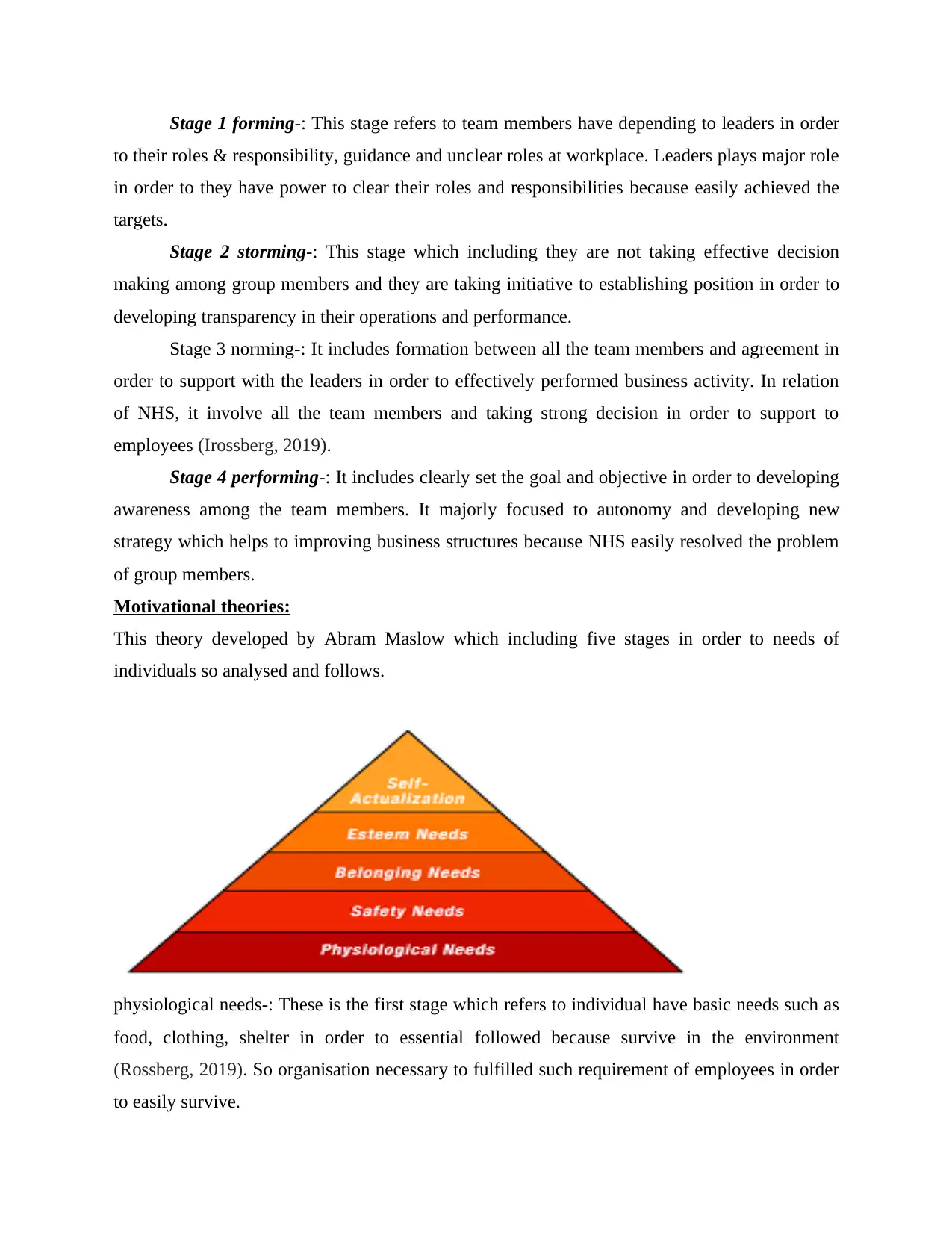
Stage 1 forming-: This stage refers to team members have depending to leaders in order
to their roles & responsibility, guidance and unclear roles at workplace. Leaders plays major role
in order to they have power to clear their roles and responsibilities because easily achieved the
targets.
Stage 2 storming-: This stage which including they are not taking effective decision
making among group members and they are taking initiative to establishing position in order to
developing transparency in their operations and performance.
Stage 3 norming-: It includes formation between all the team members and agreement in
order to support with the leaders in order to effectively performed business activity. In relation
of NHS, it involve all the team members and taking strong decision in order to support to
employees (Irossberg, 2019).
Stage 4 performing-: It includes clearly set the goal and objective in order to developing
awareness among the team members. It majorly focused to autonomy and developing new
strategy which helps to improving business structures because NHS easily resolved the problem
of group members.
Motivational theories:
This theory developed by Abram Maslow which including five stages in order to needs of
individuals so analysed and follows.
physiological needs-: These is the first stage which refers to individual have basic needs such as
food, clothing, shelter in order to essential followed because survive in the environment
(Rossberg, 2019). So organisation necessary to fulfilled such requirement of employees in order
to easily survive.
to their roles & responsibility, guidance and unclear roles at workplace. Leaders plays major role
in order to they have power to clear their roles and responsibilities because easily achieved the
targets.
Stage 2 storming-: This stage which including they are not taking effective decision
making among group members and they are taking initiative to establishing position in order to
developing transparency in their operations and performance.
Stage 3 norming-: It includes formation between all the team members and agreement in
order to support with the leaders in order to effectively performed business activity. In relation
of NHS, it involve all the team members and taking strong decision in order to support to
employees (Irossberg, 2019).
Stage 4 performing-: It includes clearly set the goal and objective in order to developing
awareness among the team members. It majorly focused to autonomy and developing new
strategy which helps to improving business structures because NHS easily resolved the problem
of group members.
Motivational theories:
This theory developed by Abram Maslow which including five stages in order to needs of
individuals so analysed and follows.
physiological needs-: These is the first stage which refers to individual have basic needs such as
food, clothing, shelter in order to essential followed because survive in the environment
(Rossberg, 2019). So organisation necessary to fulfilled such requirement of employees in order
to easily survive.
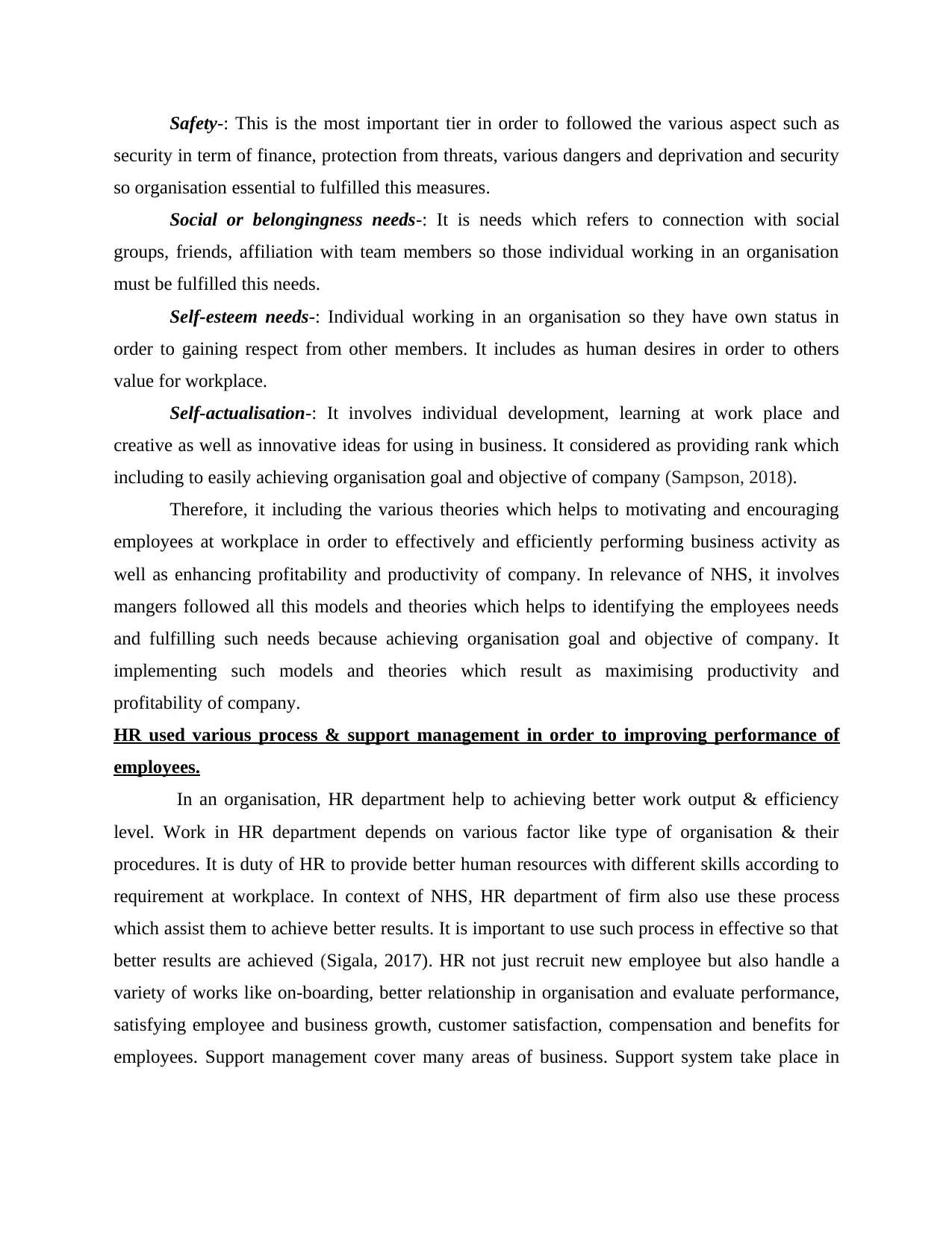
Safety-: This is the most important tier in order to followed the various aspect such as
security in term of finance, protection from threats, various dangers and deprivation and security
so organisation essential to fulfilled this measures.
Social or belongingness needs-: It is needs which refers to connection with social
groups, friends, affiliation with team members so those individual working in an organisation
must be fulfilled this needs.
Self-esteem needs-: Individual working in an organisation so they have own status in
order to gaining respect from other members. It includes as human desires in order to others
value for workplace.
Self-actualisation-: It involves individual development, learning at work place and
creative as well as innovative ideas for using in business. It considered as providing rank which
including to easily achieving organisation goal and objective of company (Sampson, 2018).
Therefore, it including the various theories which helps to motivating and encouraging
employees at workplace in order to effectively and efficiently performing business activity as
well as enhancing profitability and productivity of company. In relevance of NHS, it involves
mangers followed all this models and theories which helps to identifying the employees needs
and fulfilling such needs because achieving organisation goal and objective of company. It
implementing such models and theories which result as maximising productivity and
profitability of company.
HR used various process & support management in order to improving performance of
employees.
In an organisation, HR department help to achieving better work output & efficiency
level. Work in HR department depends on various factor like type of organisation & their
procedures. It is duty of HR to provide better human resources with different skills according to
requirement at workplace. In context of NHS, HR department of firm also use these process
which assist them to achieve better results. It is important to use such process in effective so that
better results are achieved (Sigala, 2017). HR not just recruit new employee but also handle a
variety of works like on-boarding, better relationship in organisation and evaluate performance,
satisfying employee and business growth, customer satisfaction, compensation and benefits for
employees. Support management cover many areas of business. Support system take place in
security in term of finance, protection from threats, various dangers and deprivation and security
so organisation essential to fulfilled this measures.
Social or belongingness needs-: It is needs which refers to connection with social
groups, friends, affiliation with team members so those individual working in an organisation
must be fulfilled this needs.
Self-esteem needs-: Individual working in an organisation so they have own status in
order to gaining respect from other members. It includes as human desires in order to others
value for workplace.
Self-actualisation-: It involves individual development, learning at work place and
creative as well as innovative ideas for using in business. It considered as providing rank which
including to easily achieving organisation goal and objective of company (Sampson, 2018).
Therefore, it including the various theories which helps to motivating and encouraging
employees at workplace in order to effectively and efficiently performing business activity as
well as enhancing profitability and productivity of company. In relevance of NHS, it involves
mangers followed all this models and theories which helps to identifying the employees needs
and fulfilling such needs because achieving organisation goal and objective of company. It
implementing such models and theories which result as maximising productivity and
profitability of company.
HR used various process & support management in order to improving performance of
employees.
In an organisation, HR department help to achieving better work output & efficiency
level. Work in HR department depends on various factor like type of organisation & their
procedures. It is duty of HR to provide better human resources with different skills according to
requirement at workplace. In context of NHS, HR department of firm also use these process
which assist them to achieve better results. It is important to use such process in effective so that
better results are achieved (Sigala, 2017). HR not just recruit new employee but also handle a
variety of works like on-boarding, better relationship in organisation and evaluate performance,
satisfying employee and business growth, customer satisfaction, compensation and benefits for
employees. Support management cover many areas of business. Support system take place in
⊘ This is a preview!⊘
Do you want full access?
Subscribe today to unlock all pages.

Trusted by 1+ million students worldwide
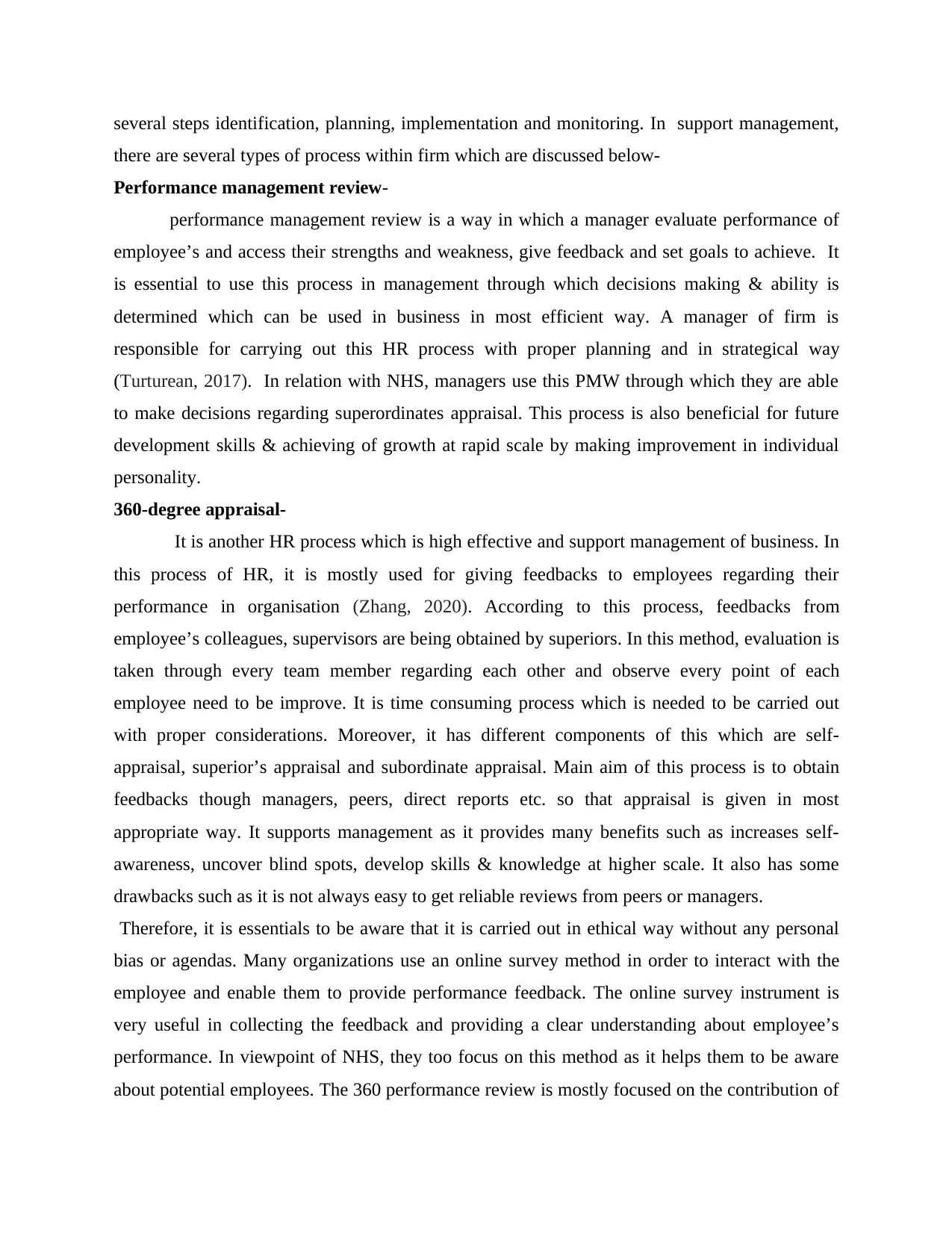
several steps identification, planning, implementation and monitoring. In support management,
there are several types of process within firm which are discussed below-
Performance management review-
performance management review is a way in which a manager evaluate performance of
employee’s and access their strengths and weakness, give feedback and set goals to achieve. It
is essential to use this process in management through which decisions making & ability is
determined which can be used in business in most efficient way. A manager of firm is
responsible for carrying out this HR process with proper planning and in strategical way
(Turturean, 2017). In relation with NHS, managers use this PMW through which they are able
to make decisions regarding superordinates appraisal. This process is also beneficial for future
development skills & achieving of growth at rapid scale by making improvement in individual
personality.
360-degree appraisal-
It is another HR process which is high effective and support management of business. In
this process of HR, it is mostly used for giving feedbacks to employees regarding their
performance in organisation (Zhang, 2020). According to this process, feedbacks from
employee’s colleagues, supervisors are being obtained by superiors. In this method, evaluation is
taken through every team member regarding each other and observe every point of each
employee need to be improve. It is time consuming process which is needed to be carried out
with proper considerations. Moreover, it has different components of this which are self-
appraisal, superior’s appraisal and subordinate appraisal. Main aim of this process is to obtain
feedbacks though managers, peers, direct reports etc. so that appraisal is given in most
appropriate way. It supports management as it provides many benefits such as increases self-
awareness, uncover blind spots, develop skills & knowledge at higher scale. It also has some
drawbacks such as it is not always easy to get reliable reviews from peers or managers.
Therefore, it is essentials to be aware that it is carried out in ethical way without any personal
bias or agendas. Many organizations use an online survey method in order to interact with the
employee and enable them to provide performance feedback. The online survey instrument is
very useful in collecting the feedback and providing a clear understanding about employee’s
performance. In viewpoint of NHS, they too focus on this method as it helps them to be aware
about potential employees. The 360 performance review is mostly focused on the contribution of
there are several types of process within firm which are discussed below-
Performance management review-
performance management review is a way in which a manager evaluate performance of
employee’s and access their strengths and weakness, give feedback and set goals to achieve. It
is essential to use this process in management through which decisions making & ability is
determined which can be used in business in most efficient way. A manager of firm is
responsible for carrying out this HR process with proper planning and in strategical way
(Turturean, 2017). In relation with NHS, managers use this PMW through which they are able
to make decisions regarding superordinates appraisal. This process is also beneficial for future
development skills & achieving of growth at rapid scale by making improvement in individual
personality.
360-degree appraisal-
It is another HR process which is high effective and support management of business. In
this process of HR, it is mostly used for giving feedbacks to employees regarding their
performance in organisation (Zhang, 2020). According to this process, feedbacks from
employee’s colleagues, supervisors are being obtained by superiors. In this method, evaluation is
taken through every team member regarding each other and observe every point of each
employee need to be improve. It is time consuming process which is needed to be carried out
with proper considerations. Moreover, it has different components of this which are self-
appraisal, superior’s appraisal and subordinate appraisal. Main aim of this process is to obtain
feedbacks though managers, peers, direct reports etc. so that appraisal is given in most
appropriate way. It supports management as it provides many benefits such as increases self-
awareness, uncover blind spots, develop skills & knowledge at higher scale. It also has some
drawbacks such as it is not always easy to get reliable reviews from peers or managers.
Therefore, it is essentials to be aware that it is carried out in ethical way without any personal
bias or agendas. Many organizations use an online survey method in order to interact with the
employee and enable them to provide performance feedback. The online survey instrument is
very useful in collecting the feedback and providing a clear understanding about employee’s
performance. In viewpoint of NHS, they too focus on this method as it helps them to be aware
about potential employees. The 360 performance review is mostly focused on the contribution of
Paraphrase This Document
Need a fresh take? Get an instant paraphrase of this document with our AI Paraphraser
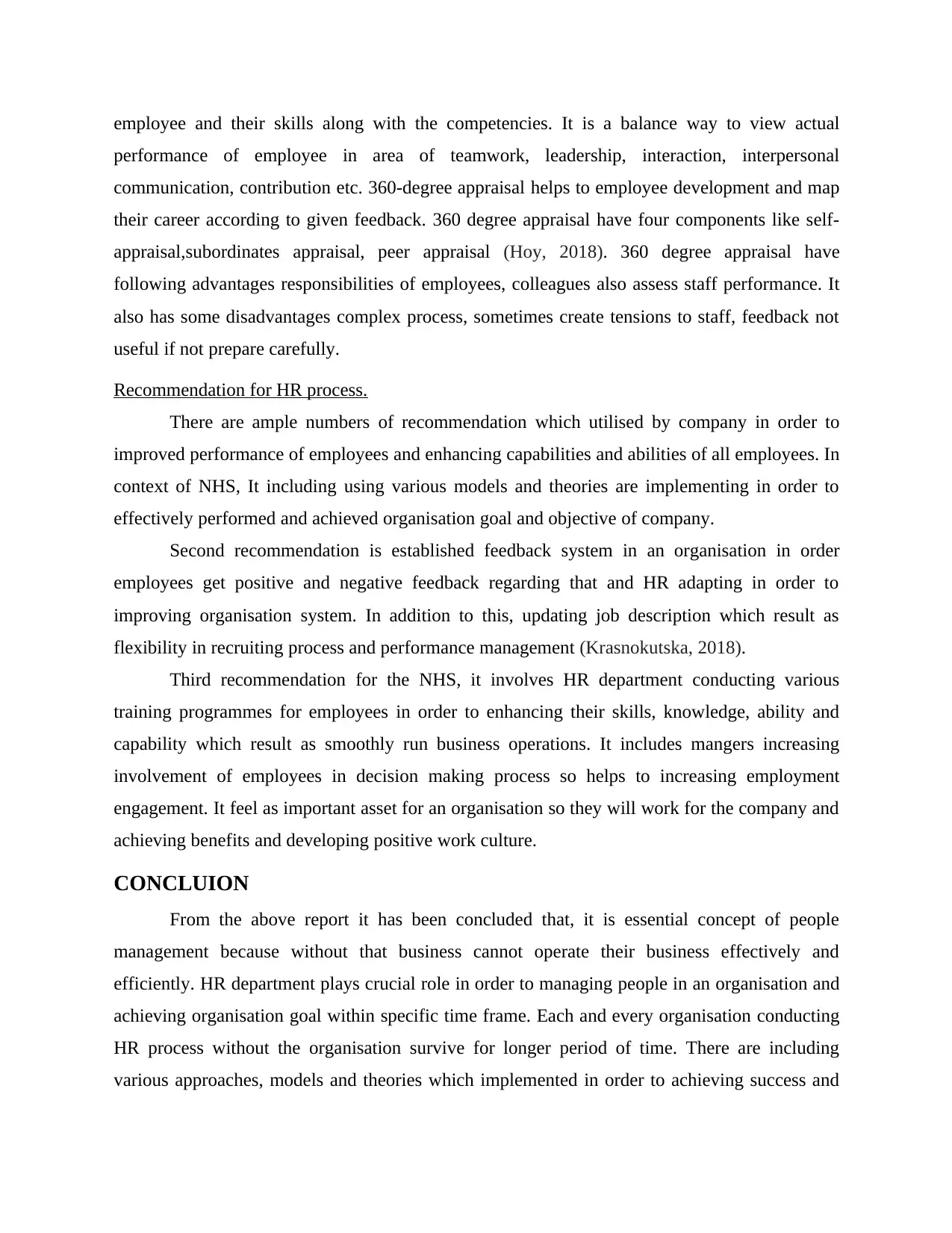
employee and their skills along with the competencies. It is a balance way to view actual
performance of employee in area of teamwork, leadership, interaction, interpersonal
communication, contribution etc. 360-degree appraisal helps to employee development and map
their career according to given feedback. 360 degree appraisal have four components like self-
appraisal,subordinates appraisal, peer appraisal (Hoy, 2018). 360 degree appraisal have
following advantages responsibilities of employees, colleagues also assess staff performance. It
also has some disadvantages complex process, sometimes create tensions to staff, feedback not
useful if not prepare carefully.
Recommendation for HR process.
There are ample numbers of recommendation which utilised by company in order to
improved performance of employees and enhancing capabilities and abilities of all employees. In
context of NHS, It including using various models and theories are implementing in order to
effectively performed and achieved organisation goal and objective of company.
Second recommendation is established feedback system in an organisation in order
employees get positive and negative feedback regarding that and HR adapting in order to
improving organisation system. In addition to this, updating job description which result as
flexibility in recruiting process and performance management (Krasnokutska, 2018).
Third recommendation for the NHS, it involves HR department conducting various
training programmes for employees in order to enhancing their skills, knowledge, ability and
capability which result as smoothly run business operations. It includes mangers increasing
involvement of employees in decision making process so helps to increasing employment
engagement. It feel as important asset for an organisation so they will work for the company and
achieving benefits and developing positive work culture.
CONCLUION
From the above report it has been concluded that, it is essential concept of people
management because without that business cannot operate their business effectively and
efficiently. HR department plays crucial role in order to managing people in an organisation and
achieving organisation goal within specific time frame. Each and every organisation conducting
HR process without the organisation survive for longer period of time. There are including
various approaches, models and theories which implemented in order to achieving success and
performance of employee in area of teamwork, leadership, interaction, interpersonal
communication, contribution etc. 360-degree appraisal helps to employee development and map
their career according to given feedback. 360 degree appraisal have four components like self-
appraisal,subordinates appraisal, peer appraisal (Hoy, 2018). 360 degree appraisal have
following advantages responsibilities of employees, colleagues also assess staff performance. It
also has some disadvantages complex process, sometimes create tensions to staff, feedback not
useful if not prepare carefully.
Recommendation for HR process.
There are ample numbers of recommendation which utilised by company in order to
improved performance of employees and enhancing capabilities and abilities of all employees. In
context of NHS, It including using various models and theories are implementing in order to
effectively performed and achieved organisation goal and objective of company.
Second recommendation is established feedback system in an organisation in order
employees get positive and negative feedback regarding that and HR adapting in order to
improving organisation system. In addition to this, updating job description which result as
flexibility in recruiting process and performance management (Krasnokutska, 2018).
Third recommendation for the NHS, it involves HR department conducting various
training programmes for employees in order to enhancing their skills, knowledge, ability and
capability which result as smoothly run business operations. It includes mangers increasing
involvement of employees in decision making process so helps to increasing employment
engagement. It feel as important asset for an organisation so they will work for the company and
achieving benefits and developing positive work culture.
CONCLUION
From the above report it has been concluded that, it is essential concept of people
management because without that business cannot operate their business effectively and
efficiently. HR department plays crucial role in order to managing people in an organisation and
achieving organisation goal within specific time frame. Each and every organisation conducting
HR process without the organisation survive for longer period of time. There are including
various approaches, models and theories which implemented in order to achieving success and
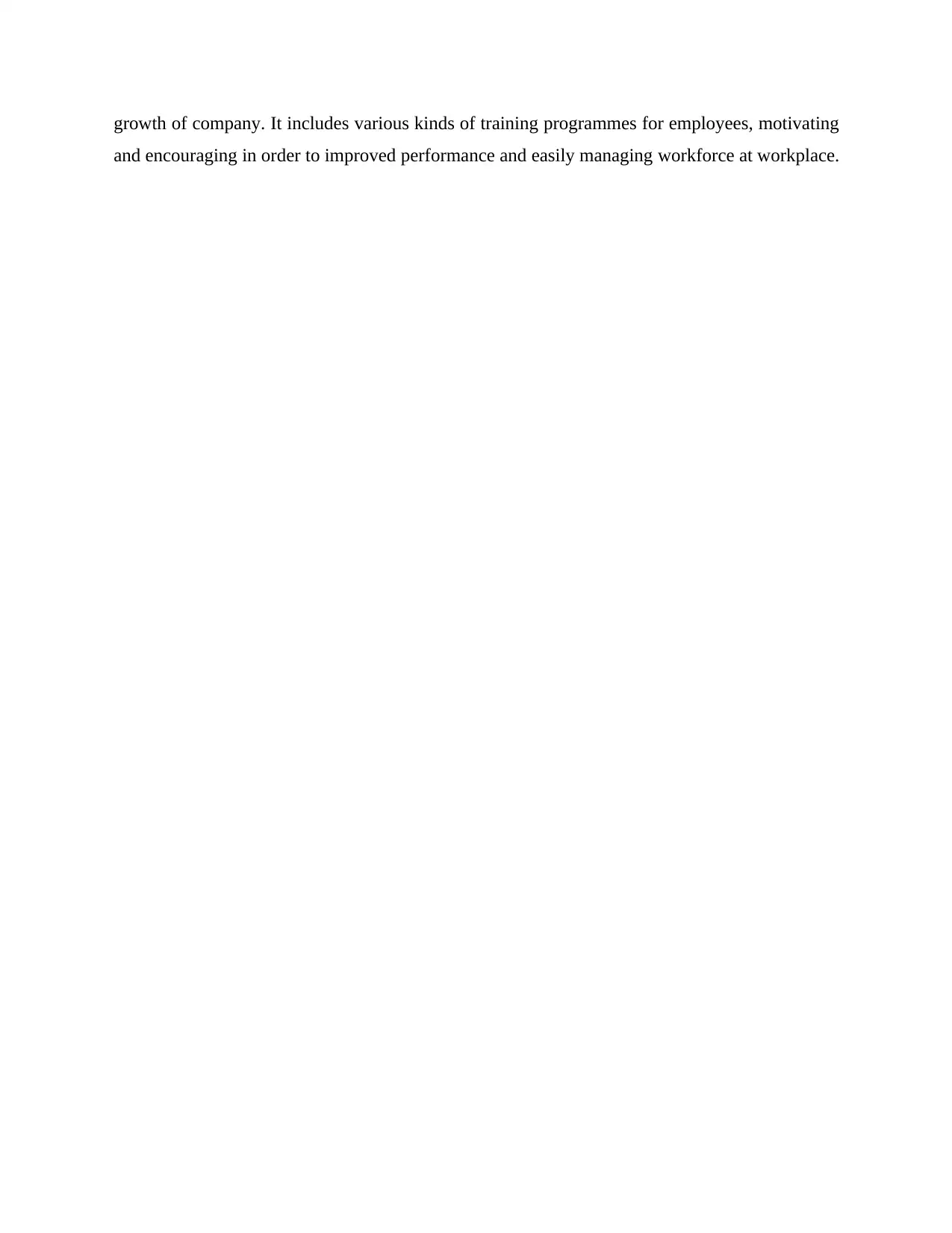
growth of company. It includes various kinds of training programmes for employees, motivating
and encouraging in order to improved performance and easily managing workforce at workplace.
and encouraging in order to improved performance and easily managing workforce at workplace.
⊘ This is a preview!⊘
Do you want full access?
Subscribe today to unlock all pages.

Trusted by 1+ million students worldwide
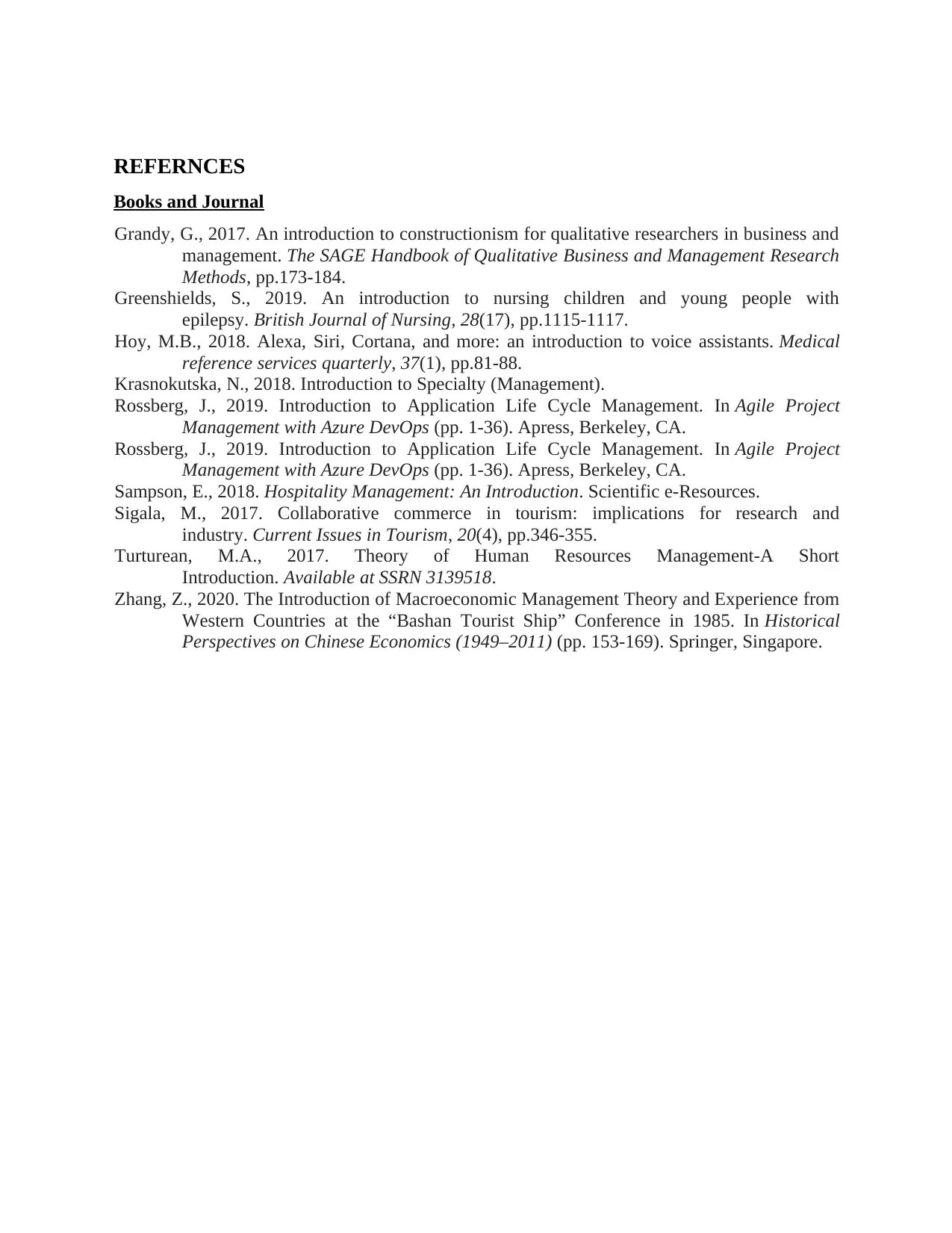
REFERNCES
Books and Journal
Grandy, G., 2017. An introduction to constructionism for qualitative researchers in business and
management. The SAGE Handbook of Qualitative Business and Management Research
Methods, pp.173-184.
Greenshields, S., 2019. An introduction to nursing children and young people with
epilepsy. British Journal of Nursing, 28(17), pp.1115-1117.
Hoy, M.B., 2018. Alexa, Siri, Cortana, and more: an introduction to voice assistants. Medical
reference services quarterly, 37(1), pp.81-88.
Krasnokutska, N., 2018. Introduction to Specialty (Management).
Rossberg, J., 2019. Introduction to Application Life Cycle Management. In Agile Project
Management with Azure DevOps (pp. 1-36). Apress, Berkeley, CA.
Rossberg, J., 2019. Introduction to Application Life Cycle Management. In Agile Project
Management with Azure DevOps (pp. 1-36). Apress, Berkeley, CA.
Sampson, E., 2018. Hospitality Management: An Introduction. Scientific e-Resources.
Sigala, M., 2017. Collaborative commerce in tourism: implications for research and
industry. Current Issues in Tourism, 20(4), pp.346-355.
Turturean, M.A., 2017. Theory of Human Resources Management-A Short
Introduction. Available at SSRN 3139518.
Zhang, Z., 2020. The Introduction of Macroeconomic Management Theory and Experience from
Western Countries at the “Bashan Tourist Ship” Conference in 1985. In Historical
Perspectives on Chinese Economics (1949–2011) (pp. 153-169). Springer, Singapore.
Books and Journal
Grandy, G., 2017. An introduction to constructionism for qualitative researchers in business and
management. The SAGE Handbook of Qualitative Business and Management Research
Methods, pp.173-184.
Greenshields, S., 2019. An introduction to nursing children and young people with
epilepsy. British Journal of Nursing, 28(17), pp.1115-1117.
Hoy, M.B., 2018. Alexa, Siri, Cortana, and more: an introduction to voice assistants. Medical
reference services quarterly, 37(1), pp.81-88.
Krasnokutska, N., 2018. Introduction to Specialty (Management).
Rossberg, J., 2019. Introduction to Application Life Cycle Management. In Agile Project
Management with Azure DevOps (pp. 1-36). Apress, Berkeley, CA.
Rossberg, J., 2019. Introduction to Application Life Cycle Management. In Agile Project
Management with Azure DevOps (pp. 1-36). Apress, Berkeley, CA.
Sampson, E., 2018. Hospitality Management: An Introduction. Scientific e-Resources.
Sigala, M., 2017. Collaborative commerce in tourism: implications for research and
industry. Current Issues in Tourism, 20(4), pp.346-355.
Turturean, M.A., 2017. Theory of Human Resources Management-A Short
Introduction. Available at SSRN 3139518.
Zhang, Z., 2020. The Introduction of Macroeconomic Management Theory and Experience from
Western Countries at the “Bashan Tourist Ship” Conference in 1985. In Historical
Perspectives on Chinese Economics (1949–2011) (pp. 153-169). Springer, Singapore.
1 out of 10
Related Documents
Your All-in-One AI-Powered Toolkit for Academic Success.
+13062052269
info@desklib.com
Available 24*7 on WhatsApp / Email
![[object Object]](/_next/static/media/star-bottom.7253800d.svg)
Unlock your academic potential
Copyright © 2020–2025 A2Z Services. All Rights Reserved. Developed and managed by ZUCOL.





